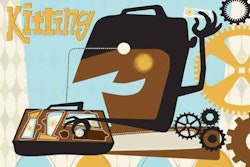
A sign in a conference room at Praxis Packaging (www.praxispackaging.com) reads: “To be prepared beforehand for any contingency is the greatest of virtues” (Sun Tzu in The Art of War). Following that philosophy, the
Here are just a few of the company’s wide-ranging recent projects that support this operational model that gives customers what they need, when they need it.
• A large electronics manufacturer asked the company to redesign packaging for its circuitry and replace polyvinyl chloride with recycled materials. Praxis developed a two-piece, heat-sealed RPET clamshell containing a die-cut virgin SBS board that suspends the product within the clear package, giving consumers a better view of the product on both sides of the package at consumer electronics stores and office supply stores.
• A major national pharmaceutical company needed nearly three million patient starter kits and standalone samples. Praxis met the company’s aggressive launch schedule by hiring and training the right employees, reconfiguring its highly flexible production lines, and working a three-shift, seven-day production schedule.
• A western
Projects such as these, on both a national and regional scale, are possible because Praxis has gone to unusual lengths to prepare itself to do virtually any project—including point-of-purchase and store display assembly, kitting, print-registered bundling, and stretch-card packaging—at almost any time. Macatawa Holdings LLC purchased the company in March 2006 and infused additional money into the operation. Capital assets have increased 27% in the first five months of 2007 and spending on worker training has escalated by 4,000% over the past two years. These investments enable Praxis to provide the cGMP-compliant facility and trained, variable work forces to broaden its capabilities They include its core pharmaceutical and OTC packaging services and the flexibility to quickly adapt its plant to shrink-wrap stacks of play money for board games and offer filling capabilities.
“I don’t have five-year plans anymore,” says Ted Etheridge, a partner at Macatawa Holdings. “I used to make them, but that’s too far out in the business of variable manufacturing. We turn on a dime. On Monday, we don’t know what we’ll be doing on Friday. If a big-box store wants rainbow packs in their stores in 24 hours, you can’t go back upstream to do that, so we have to be ready to do jobs like that here.”
Adds Scott Hanmer, vice president of sales at Praxis, “Our biggest challenge is to challenge ourselves to look for new opportunities.”
Those opportunities require mobile plant floor and precise time and work force management at the 110,000-sq-ft facility. Machinery that keeps each project humming is custom-made and mostly on wheels so it can be moved among the plant’s 16 production lines. Tooling is done in-house. The company sources packaging materials and expertise in areas such as printing from a network of regional partners, and Rick King, company president, said the plant is “comfortable” at $18 million in production capacity.
Approach to quality control
The centerpiece of Praxis’ approach to packaging line efficiency is a clever color-coded system of “visual identifiers.” Contract Packaging viewed the system in action, and hasn’t seen this communications approach used in other co-packing plants.
Each of the 16 lines is equipped with a series of colored “flags,” explains Anne Armstrong, director of quality assurance. When turned to the open position, they signal the line’s current operational status. For example, green means “running at optimal efficiency,” red represents “line stopped; quality auditor needs to check for defect,” and black communicates that “the line is idle.”
All of the production lines are situated sequentially along the main aisle to give senior managers a quick overview of the production area’s overall operational status, scrap rates, and organizational efficiency at a glance.
Product units rejected as they come off a production line are diverted into a red tote, dedicated to that line, for quality-control inspection.
Yellow portable barriers separate each production line and achieve several objectives. They identify to line inspectors and operators where production and temporary product holding areas begin and end for each job. They can be moved to allow for line mobility such as temporary conveyor configurations. They also make it easy for quality-control inspectors to identify when a product is out of place at a workstation.





























